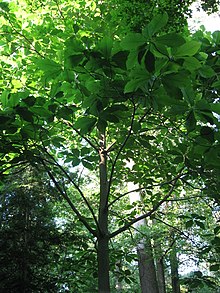Bigleaf magnolia
|
Magnolia macrophylla Bigleaf magnolia |
|
|---|---|
 |
|
| Big Leaf Magnolia | |
| Scientific classification | |
| Kingdom: | Plantae |
| (unranked): | Angiosperms |
| (unranked): | Magnoliids |
| Order: | Magnoliales |
| Family: | Magnoliaceae |
| Genus: | Magnolia |
| Subgenus: | M. subg. Magnolia |
| Section: | M. sect. Macrophylla |
| Species: | M. macrophylla |
| Binomial name | |
|
Magnolia macrophylla Michx. |
|
 |
|
| Natural range | |
Magnolia macrophylla, the bigleaf magnolia, is a deciduous magnolia native to the southeastern United States and eastern Mexico. This species boasts the largest simple leaf and single flower of any native plant in North America.
Magnolia macrophylla has three subspecies; some botanists treat these plants as three separate species:
Bigleaf magnolia is medium-sized understory tree 15–20 m tall, though some individuals over 27m tall (and over 100 cm circumference) have been documented by the Eastern Native Tree Society. This species is distinguished from other magnolias by the large leaf size, 25–80 cm long and 11–30 cm broad. The tree's branches often bend under the weight of this heavy foliage.
Bigleaf magnolia is found in rich mesic woods; any disturbance that lets more light reach the ground is beneficial to the establishment of bigleaf magnolia, but despite its relatively fast growth-rate when stimulated by more light, other understory and canopy trees/seedlings are usually able to outgrow and out-compete it. This suits the plant just fine as it is tolerant of low light levels; it does not need full sun to survive once established (however, it does not tolerate full shade). Natural regeneration is quite limited due to the scarcity of mature, seed-bearing plants and the fact that this tree's population mostly consists of widely scattered individuals. In addition, this species is plagued by poor seed set (most likely from limiting factors mentioned above) and low seed , a trait shared by its cousin and frequent associate in the wild in Appalachia, the Fraser magnolia.
The Ashe magnolia is a rare shrub, exceptionally a small tree, that is found only along the bluffs and ravines adjacent to the Apalachicola River in Florida, along with several other rare plants unique to the area, such as Florida Yew and Florida torreya. It resembles the typical subsp. macrophylla, but has shorter, broader leaves, smaller flowers, and longer fruits. The 6-to-8-inch-diameter (150 to 200 mm) flowers bloom in late spring, and are white with rose-purple blotches on the inner tepals. The fruit is eaten by wildlife, but because of the plant's scarceness, it does not form a significant portion of any creature's diet.
...
Wikipedia
